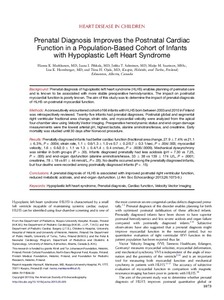Prenatal Diagnosis Improves the Postnatal Cardiac Function in a Population-Based Cohort of Infants with Hypoplastic Left Heart Syndrome
Hanna K Markkanen MD; Jaana I Pihkala MD; Jukka T Salminen MD; Maiju M Saarinen MSSc; Lisa K Hornberger MD; Tiina H; Ojala MD
Prenatal Diagnosis Improves the Postnatal Cardiac Function in a Population-Based Cohort of Infants with Hypoplastic Left Heart Syndrome
Hanna K Markkanen MD
Jaana I Pihkala MD
Jukka T Salminen MD
Maiju M Saarinen MSSc
Lisa K Hornberger MD
Tiina H
Ojala MD
Elsevier
Julkaisun pysyvä osoite on:
https://urn.fi/URN:NBN:fi-fe2021042714367
https://urn.fi/URN:NBN:fi-fe2021042714367
Tiivistelmä
Background: Prenatal diagnosis of hypoplastic left heart syndrome (HLHS) enables planning of perinatal care and is known to be associated with more stable preoperative hemodynamics. The impact on postnatal myocardial function is poorly known. The aim of this study was to determine the impact of prenatal diagnosis of HLHS on postnatal myocardial function.
Methods: A consecutively encountered cohort of 66 infants with HLHS born between 2003 and 2010 in Finland was retrospectively reviewed. Twenty-five infants had prenatal diagnoses. Postnatal global and segmental right ventricular fractional area change, strain rate, and myocardial velocity were analyzed from the apical four-chamber view using Velocity Vector Imaging. Preoperative hemodynamic status and end-organ damage
measurements were the lowest arterial pH, highest lactate, alanine aminotransferase, and creatinine. Early mortality was studied until 30 days after Norwood procedure.
Results: Prenatally diagnosed infants had better cardiac function (fractional area change, 27.9 ± 7.4% vs 21.1 ± 6.3%, P = .0004; strain rate, 1.1 ± 0.6/1.3 ± 1.0 vs 0.7 ± 0.2/0.7 ± 0.3 1/sec, P = .004/.003; myocardial velocity, 1.6 ± 0.6/2.0 ± 1.1 vs 1.3 ± 0.4/1.4 ± 0.4 cm/sec, P = .0035/.0009). Mechanical dyssynchrony was similar in both groups (P > .30). Infants diagnosed prenatally had less acidosis (pH = 7.30 vs 7.25, P = .005) and end-organ dysfunction (alanine aminotransferase, 33 ± 38 vs 139 ± 174 U/L, P = .0001;
creatinine, 78 ± 18 vs 81 ± 44 mmol/L, P = .05). No deaths occurred among the prenatally diagnosed infants, but four deaths were recorded among postnatally diagnosed infants (P = .15).
Conclusions: A prenatal diagnosis of HLHS is associated with improved postnatal right ventricular function, reduced metabolic acidosis, and end-organ dysfunction. (J Am Soc Echocardiogr 2013;26:1073-9.)
Keywords: Hypoplastic left heart syndrome, Prenatal diagnosis, Cardiac function, Velocity Vector Imaging
Methods: A consecutively encountered cohort of 66 infants with HLHS born between 2003 and 2010 in Finland was retrospectively reviewed. Twenty-five infants had prenatal diagnoses. Postnatal global and segmental right ventricular fractional area change, strain rate, and myocardial velocity were analyzed from the apical four-chamber view using Velocity Vector Imaging. Preoperative hemodynamic status and end-organ damage
measurements were the lowest arterial pH, highest lactate, alanine aminotransferase, and creatinine. Early mortality was studied until 30 days after Norwood procedure.
Results: Prenatally diagnosed infants had better cardiac function (fractional area change, 27.9 ± 7.4% vs 21.1 ± 6.3%, P = .0004; strain rate, 1.1 ± 0.6/1.3 ± 1.0 vs 0.7 ± 0.2/0.7 ± 0.3 1/sec, P = .004/.003; myocardial velocity, 1.6 ± 0.6/2.0 ± 1.1 vs 1.3 ± 0.4/1.4 ± 0.4 cm/sec, P = .0035/.0009). Mechanical dyssynchrony was similar in both groups (P > .30). Infants diagnosed prenatally had less acidosis (pH = 7.30 vs 7.25, P = .005) and end-organ dysfunction (alanine aminotransferase, 33 ± 38 vs 139 ± 174 U/L, P = .0001;
creatinine, 78 ± 18 vs 81 ± 44 mmol/L, P = .05). No deaths occurred among the prenatally diagnosed infants, but four deaths were recorded among postnatally diagnosed infants (P = .15).
Conclusions: A prenatal diagnosis of HLHS is associated with improved postnatal right ventricular function, reduced metabolic acidosis, and end-organ dysfunction. (J Am Soc Echocardiogr 2013;26:1073-9.)
Keywords: Hypoplastic left heart syndrome, Prenatal diagnosis, Cardiac function, Velocity Vector Imaging
Kokoelmat
- Rinnakkaistallenteet [27094]
